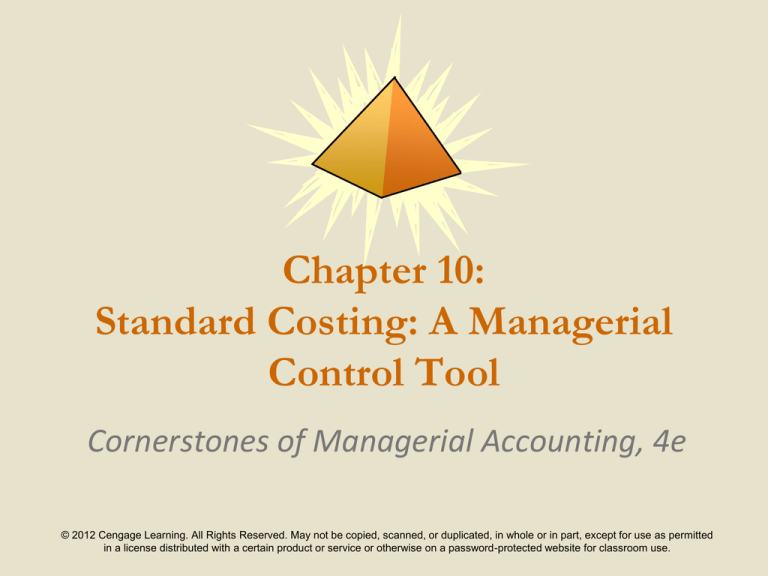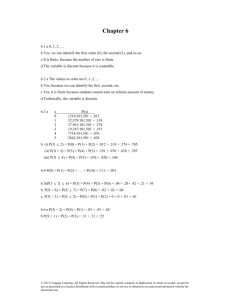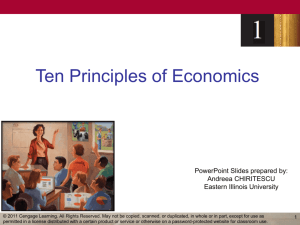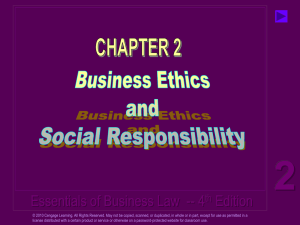
Chapter 10:
Standard Costing: A Managerial
Control Tool
Cornerstones of Managerial Accounting, 4e
© 2012 Cengage Learning. All Rights Reserved. May not be copied, scanned, or duplicated, in whole or in part, except for use as permitted
in a license distributed with a certain product or service or otherwise on a password-protected website for classroom use.
Learning Objectives
1. Explain how unit standards are set and why standard cost
systems are adopted.
2. Explain the purpose of a standard cost sheet.
3. Describe the basic concepts underlying variance analysis, and
explain when variances should be investigated.
4. Compute the materials variances, and explain how they are
used for control.
5. Compute the labor variances, and explain how they are used
for control.
6. (Appendix 10A) Prepare journal entries for materials and
labor variances.
© 2012 Cengage Learning. All Rights Reserved. May not be copied, scanned, or duplicated, in whole or in part, except for use as permitted in a
license distributed with a certain product or service or otherwise on a password-protected website for classroom use.
1
Unit Standards
►Budgets set standards that are used to control
and evaluate managerial performance.
►To determine the unit standard cost for a
particular input, two decisions must be made:
►The quantity decision: The amount of input that
should be used per unit of output
►The pricing decision: The amount that should be
paid for the quantity of the input to be used
© 2012 Cengage Learning. All Rights Reserved. May not be copied, scanned, or duplicated, in whole or in part, except for use as permitted in a
license distributed with a certain product or service or otherwise on a password-protected website for classroom use.
1
Quantity and Price Standards
►The quantity decision produces quantity
standards.
►The pricing decision produces price standards.
►The unit standard cost can be computed by
multiplying these two standards:
Standard cost per unit = Quantity standard x Price standard
© 2012 Cengage Learning. All Rights Reserved. May not be copied, scanned, or duplicated, in whole or in part, except for use as permitted in a
license distributed with a certain product or service or otherwise on a password-protected website for classroom use.
1
How Standards Are Developed
►Three potential sources of quantitative standards are as
follows:
►Historical experience: Historical experience can provide an
initial guideline for setting standards, but should be used with
caution because they can perpetuate existing inefficiencies.
►Engineering studies: Engineering studies can identify efficient
approaches rigorous guidelines, but engineered standards
often are too rigorous.
►Input from operating personnel: Since operating personnel
are accountable for meeting standards, they should have
significant input in setting standards.
© 2012 Cengage Learning. All Rights Reserved. May not be copied, scanned, or duplicated, in whole or in part, except for use as permitted in a
license distributed with a certain product or service or otherwise on a password-protected website for classroom use.
1
Types of Standards
►Standards are generally classified as either ideal or
currently attainable.
Ideal standards demand maximum
efficiency and can be achieved only if
everything operates perfectly. No machine
breakdowns, slack, or lack of skill (even
momentarily) are allowed.
Currently attainable standards can be
achieved under efficient operating
conditions. Allowance is made for normal
breakdowns, interruptions, less than
perfect skill, and so on. These standards
are demanding but achievable.
►Of the two types, currently attainable standards offer the
most behavioral benefits.
© 2012 Cengage Learning. All Rights Reserved. May not be copied, scanned, or duplicated, in whole or in part, except for use as permitted in a
license distributed with a certain product or service or otherwise on a password-protected website for classroom use.
1
Why Standard Cost Systems
Are Adopted
► Two reasons for adopting a standard cost system are frequently
mentioned:
►To improve planning and control
►Comparing actual costs with budgeted costs identifies variances, the
difference between the actual and planned costs for the actual level of
activity. Overall variances can be further broken down into a price
variance or a usage or efficiency variance if unit price or quantity
standards have been developed. This additional information is very
helpful for managers.
►To facilitate product costing
►Costs are assigned to products using quantity and price standards for
all three manufacturing costs: direct materials, direct labor, and
overhead.
► Standard costing and variance analysis for controlling cost and
evaluating performance can have strong ethical implications.
© 2012 Cengage Learning. All Rights Reserved. May not be copied, scanned, or duplicated, in whole or in part, except for use as permitted in a
license distributed with a certain product or service or otherwise on a password-protected website for classroom use.
1
Cost Assignment Approaches
© 2012 Cengage Learning. All Rights Reserved. May not be copied, scanned, or duplicated, in whole or in part, except for use as permitted in a
license distributed with a certain product or service or otherwise on a password-protected website for classroom use.
1
Advantages of
Standard Product Costing
►Standard product costing has several advantages over
normal costing and actual costing.
►Greater capacity for control
►Provides readily available unit cost information that can be
used for pricing decisions at any time throughout the period
because actual costs do not need to be known
►No unit cost calculations for each equivalent unit category in
process costing
►No need to distinguish between FIFO and weighted average
methods of accounting for beginning inventory costs
© 2012 Cengage Learning. All Rights Reserved. May not be copied, scanned, or duplicated, in whole or in part, except for use as permitted in a
license distributed with a certain product or service or otherwise on a password-protected website for classroom use.
2
Standard Product Costs
►In manufacturing firms, standard costs are
developed for direct materials, direct labor, and
overhead.
►Using these costs, the standard cost per unit is
computed.
►The standard cost sheet provides the production
data needed to calculate the standard unit cost.
© 2012 Cengage Learning. All Rights Reserved. May not be copied, scanned, or duplicated, in whole or in part, except for use as permitted in a
license distributed with a certain product or service or otherwise on a password-protected website for classroom use.
The Standard Cost Sheet
2
► The standard cost sheet also
shows the quantity of each
input that should be used to
produce one unit of output.
► A manager should be able to
compute the standard
quantity of materials
allowed (SQ) and the
standard hours allowed (SH)
for the actual output, where
and
© 2012 Cengage Learning. All Rights Reserved. May not be copied, scanned, or duplicated, in whole or in part, except for use as permitted in a
license distributed with a certain product or service or otherwise on a password-protected website for classroom use.
2
Cornerstone 10-1
Computing Standard Quantities Allowed
(SQ & SH)
© 2012 Cengage Learning. All Rights Reserved. May not be copied, scanned, or duplicated, in whole or in part, except for use as permitted in a
license distributed with a certain product or service or otherwise on a password-protected website for classroom use.
3
Variance Analysis:
General Description
►Actual input cost can be calculated as:
Actual cost = AP x AQ
► where
AP = Actual price per unit
AQ = Actual quantity of input used
►It is also possible to calculate the costs that should have
been incurred for the actual level of activity.
Planned cost = SP x SQ
► where
SP = Standard price per unit
SQ = Standard quantity of input allowed for the
actual output
© 2012 Cengage Learning. All Rights Reserved. May not be copied, scanned, or duplicated, in whole or in part, except for use as permitted in a
license distributed with a certain product or service or otherwise on a password-protected website for classroom use.
3
Total Budget Variance
►The total budget variance is the difference between the
actual cost of the input and its planned cost:
► Because responsibility for deviations from planned prices tends
to be located in the purchasing or personnel department and
responsibility for deviations from planned usage of inputs tends
to be located in the production department, it is important to
separate the total variance into price and usage (quantity)
variances.
© 2012 Cengage Learning. All Rights Reserved. May not be copied, scanned, or duplicated, in whole or in part, except for use as permitted in a
license distributed with a certain product or service or otherwise on a password-protected website for classroom use.
3
Price and Usage Variances
►For labor, the price variance is usually called a rate variance.
►Price (rate) variance is the difference between the actual
and standard unit price of an input multiplied by the number
of inputs used:
Price variance = (AP - SP) x AQ
►The usage (quantity) variance is called an efficiency variance.
►Usage (efficiency) variance is the difference between the
actual and standard quantity of inputs multiplied by the
standard unit price of the input:
Usage variance = (AQ - SQ) x SP
© 2012 Cengage Learning. All Rights Reserved. May not be copied, scanned, or duplicated, in whole or in part, except for use as permitted in a
license distributed with a certain product or service or otherwise on a password-protected website for classroom use.
3 Variance Analysis: General Description
© 2012 Cengage Learning. All Rights Reserved. May not be copied, scanned, or duplicated, in whole or in part, except for use as permitted in a
license distributed with a certain product or service or otherwise on a password-protected website for classroom use.
3
Unfavorable and Favorable
Variances
►Unfavorable (U) variances occur whenever actual
prices or actual usage of inputs are greater than
standard prices or standard usage.
►When the opposite occurs, favorable (F) variances are
obtained.
►Favorable and unfavorable variances are not equivalent
to good and bad variances. The terms merely indicate
the relationship of the actual prices (or quantities) to
the standard prices (or quantities).
© 2012 Cengage Learning. All Rights Reserved. May not be copied, scanned, or duplicated, in whole or in part, except for use as permitted in a
license distributed with a certain product or service or otherwise on a password-protected website for classroom use.
3
The Decision to Investigate
►As a general principle, an investigation
should be undertaken only if the expected
benefits are greater than the expected costs.
►Managers determine whether variances are
significant based on an acceptable range
that has top and bottom measures called
control limits.
© 2012 Cengage Learning. All Rights Reserved. May not be copied, scanned, or duplicated, in whole or in part, except for use as permitted in a
license distributed with a certain product or service or otherwise on a password-protected website for classroom use.
3
Cornerstone 10-2
Using Control Limits to Trigger A
Variance Investigation
© 2012 Cengage Learning. All Rights Reserved. May not be copied, scanned, or duplicated, in whole or in part, except for use as permitted in a
license distributed with a certain product or service or otherwise on a password-protected website for classroom use.
3
Cornerstone 10-2
Using Control Limits to Trigger A
Variance Investigation (continued)
© 2012 Cengage Learning. All Rights Reserved. May not be copied, scanned, or duplicated, in whole or in part, except for use as permitted in a
license distributed with a certain product or service or otherwise on a password-protected website for classroom use.
4
Variance Analysis: Materials
►The total variance for materials measures the
difference between the actual costs of materials
and their budgeted costs for the actual level of
activity:
Total Variance = Actual cost - Planned cost
= (AP x AQ) - (SP x SQ)
© 2012 Cengage Learning. All Rights Reserved. May not be copied, scanned, or duplicated, in whole or in part, except for use as permitted in a
license distributed with a certain product or service or otherwise on a password-protected website for classroom use.
4
Cornerstone 10-3
Calculating the Total Variance for
Materials
© 2012 Cengage Learning. All Rights Reserved. May not be copied, scanned, or duplicated, in whole or in part, except for use as permitted in a
license distributed with a certain product or service or otherwise on a password-protected website for classroom use.
4
Direct Materials Variances
►To help control the cost of materials, price and
usage variances are calculated.
►The materials price variance is computed by
using the actual quantity of materials purchased,
and the materials usage variance is computed by
using the actual quantity of materials used,
calculated as:
© 2012 Cengage Learning. All Rights Reserved. May not be copied, scanned, or duplicated, in whole or in part, except for use as permitted in a
license distributed with a certain product or service or otherwise on a password-protected website for classroom use.
4
Cornerstone 10-4
Calculating Materials Variances:
Formula and Columnar Approaches
© 2012 Cengage Learning. All Rights Reserved. May not be copied, scanned, or duplicated, in whole or in part, except for use as permitted in a
license distributed with a certain product or service or otherwise on a password-protected website for classroom use.
4
Cornerstone 10-4
Calculating Materials Variances:
Formula and Columnar Approaches
(continued)
© 2012 Cengage Learning. All Rights Reserved. May not be copied, scanned, or duplicated, in whole or in part, except for use as permitted in a
license distributed with a certain product or service or otherwise on a password-protected website for classroom use.
4
Materials Price Variance
►The materials price variance (MPV) measures the
difference between what should have been paid for raw
materials and what was actually paid and is calculated
as:
MPV = (AP - SP) x AQ
►Where
AP = Actual price per unit
SP = Standard price per unit
AQ = Actual quantity of material purchased
© 2012 Cengage Learning. All Rights Reserved. May not be copied, scanned, or duplicated, in whole or in part, except for use as permitted in a
license distributed with a certain product or service or otherwise on a password-protected website for classroom use.
4
Materials Usage Variance
►The materials usage variance (MUV) measures the
difference between the direct materials actually used
and the direct materials that should have been used for
the actual output. The formula is:
MUV = (AQ - SQ) x SP
► Where
AQ = Actual quantity of materials used
SQ = Standard quantity of materials allowed for the actual output
SP = Standard price per unit
© 2012 Cengage Learning. All Rights Reserved. May not be copied, scanned, or duplicated, in whole or in part, except for use as permitted in a
license distributed with a certain product or service or otherwise on a password-protected website for classroom use.
4
Using Materials Variance
Information
►Calculating materials variances is only the first
step.
►Using the variance information to exercise
control is fundamental to a standard cost
system.
►Responsibility must be assigned, variance
significance must be assessed, and the variances
must be accounted for and disposed of at the
end of the year.
© 2012 Cengage Learning. All Rights Reserved. May not be copied, scanned, or duplicated, in whole or in part, except for use as permitted in a
license distributed with a certain product or service or otherwise on a password-protected website for classroom use.
4
Responsibility for
Materials Price Variance
►The responsibility for controlling the materials price
variance usually belongs to the purchasing agent.
►Admittedly, the price of materials is largely beyond the
agent’s control and can have undesirable outcomes
from an evaluation perspective.
►Pressure to produce favorable variances may result in
the purchase of materials of lower quality than desired
or excessive inventory purchases in order to get
quantity discounts.
© 2012 Cengage Learning. All Rights Reserved. May not be copied, scanned, or duplicated, in whole or in part, except for use as permitted in a
license distributed with a certain product or service or otherwise on a password-protected website for classroom use.
4
The Analysis of
Materials Price Variance
►The first step in variance analysis is to decide whether
the variance is significant.
►If so, what is its cause?
►Once the reason is known, corrective action can be
taken if necessary—and if possible.
►For example, if high quality materials were purchased
due to a supply shortage of usual materials, no action is
needed. A firm has no control over the supply shortage;
it will simply have to wait until market conditions
improve.
►If the variance is judged insignificant, no further steps
are needed.
© 2012 Cengage Learning. All Rights Reserved. May not be copied, scanned, or duplicated, in whole or in part, except for use as permitted in a
license distributed with a certain product or service or otherwise on a password-protected website for classroom use.
4
Responsibility for
Materials Usage Variance
►The responsibility for controlling the materials usage
usually belongs to the production manager.
►Minimizing scrap, waste, and rework are all ways in
which the manager can ensure that the standard is met.
►However, at times, the cause of the variance is
attributable to others outside the production area.
►Pressure to produce favorable variances may allow
defective units to be transferred to finished goods and
ultimately cause customer relations problems.
© 2012 Cengage Learning. All Rights Reserved. May not be copied, scanned, or duplicated, in whole or in part, except for use as permitted in a
license distributed with a certain product or service or otherwise on a password-protected website for classroom use.
4
The Analysis of
Materials Usage Variance
►If variance is significant, investigation is needed to find
out the causes for the deviation.
►It is important to note that standards are not static.
►As improvements in production take place and
conditions change, standards may need to be revised to
reflect the new operating environment.
►The importance of evaluating current business
conditions and updating standards to reflect any
changes in these conditions cannot be overlooked.
© 2012 Cengage Learning. All Rights Reserved. May not be copied, scanned, or duplicated, in whole or in part, except for use as permitted in a
license distributed with a certain product or service or otherwise on a password-protected website for classroom use.
4
Accounting and Disposition of
Materials Variances
►Recognizing the price variance for materials at the point
of purchase also means that the raw materials inventory
is carried at standard cost.
►In general, materials variances are not inventoried.
►Typically, materials variances are added to cost of goods
sold if unfavorable and are subtracted from cost of
goods sold if favorable.
© 2012 Cengage Learning. All Rights Reserved. May not be copied, scanned, or duplicated, in whole or in part, except for use as permitted in a
license distributed with a certain product or service or otherwise on a password-protected website for classroom use.
4
You Decide
Relationship between MPV and MUV
© 2012 Cengage Learning. All Rights Reserved. May not be copied, scanned, or duplicated, in whole or in part, except for use as permitted in a
license distributed with a certain product or service or otherwise on a password-protected website for classroom use.
4
You Decide
Relationship between MPV and MUV
(continued)
© 2012 Cengage Learning. All Rights Reserved. May not be copied, scanned, or duplicated, in whole or in part, except for use as permitted in a
license distributed with a certain product or service or otherwise on a password-protected website for classroom use.
5
Variance Analysis:
Direct Labor
►The total labor variance measures the difference
between the actual costs of labor and their
budgeted costs for the actual level of activity:
© 2012 Cengage Learning. All Rights Reserved. May not be copied, scanned, or duplicated, in whole or in part, except for use as permitted in a
license distributed with a certain product or service or otherwise on a password-protected website for classroom use.
5
Cornerstone 10-5
Calculating the Total Variance for Labor
© 2012 Cengage Learning. All Rights Reserved. May not be copied, scanned, or duplicated, in whole or in part, except for use as permitted in a
license distributed with a certain product or service or otherwise on a password-protected website for classroom use.
5
Direct Labor Variances
►Labor hours cannot be purchased and stored for future use
as can be done with materials (i.e., there can be no
difference between the amount of labor purchased and the
amount of labor used).
►Therefore, unlike the total materials variance, the labor rate and
labor efficiency variances always will add up to the total labor
variance.
►The rate (price) and efficiency (usage) variances for labor can be
calculated by using either the columnar approach or the
associated formulas.
Total labor variance = Labor rate variance + Labor efficiency variance
© 2012 Cengage Learning. All Rights Reserved. May not be copied, scanned, or duplicated, in whole or in part, except for use as permitted in a
license distributed with a certain product or service or otherwise on a password-protected website for classroom use.
5
Labor Rate Variance
►The labor rate variance (LRV) computes the
difference between what was paid to direct
laborers and what should have been paid:
LRV = (AR - SR) x AH
►where
AR = Actual hourly wage rate
SR = Standard hourly wage rate
AH = Actual direct labor hours used
© 2012 Cengage Learning. All Rights Reserved. May not be copied, scanned, or duplicated, in whole or in part, except for use as permitted in a
license distributed with a certain product or service or otherwise on a password-protected website for classroom use.
Labor Efficiency Variance
5
►The labor efficiency variance (LEV) measures the
difference between the labor hours that were
actually used and the labor hours that should have
been used:
LEV = (AH - SH) x SR
►where
AH = Actual direct labor hours used
SH = Standard direct labor hours that should have been used
SR = Standard hourly wage rate
© 2012 Cengage Learning. All Rights Reserved. May not be copied, scanned, or duplicated, in whole or in part, except for use as permitted in a
license distributed with a certain product or service or otherwise on a password-protected website for classroom use.
5
Cornerstone 10-6
Calculating Labor Variances: Formula and
Columnar Approaches
© 2012 Cengage Learning. All Rights Reserved. May not be copied, scanned, or duplicated, in whole or in part, except for use as permitted in a
license distributed with a certain product or service or otherwise on a password-protected website for classroom use.
5
Cornerstone 10-6
Calculating Labor Variances: Formula and
Columnar Approaches (continued)
© 2012 Cengage Learning. All Rights Reserved. May not be copied, scanned, or duplicated, in whole or in part, except for use as permitted in a
license distributed with a certain product or service or otherwise on a password-protected website for classroom use.
5
Using Labor Variance Information
►Calculating labor variances initiates the feedback
process.
►Using the labor variance information to exercise
control is fundamental.
►Responsibility must be assigned, variance
significance must be assessed, and the variances
must be accounted for and disposed of at the
end of the year.
© 2012 Cengage Learning. All Rights Reserved. May not be copied, scanned, or duplicated, in whole or in part, except for use as permitted in a
license distributed with a certain product or service or otherwise on a password-protected website for classroom use.
5
Responsibility for
the Labor Rate Variance
►Labor rates are largely determined by such external
forces as labor markets and union contracts.
►Departures of actual rates from standard rates are rare
and variances are usually due to unexpected overtime
or the use of higher paid employees for less skilled
tasks.
►The use of labor is controllable by the production
manager, so responsibility for the labor rate variance
generally is assigned to the individuals who decide how
labor will be used.
© 2012 Cengage Learning. All Rights Reserved. May not be copied, scanned, or duplicated, in whole or in part, except for use as permitted in a
license distributed with a certain product or service or otherwise on a password-protected website for classroom use.
5
Responsibility for
the Labor Efficiency Variance
►Generally speaking, production managers are
responsible for the productive use of direct labor.
► However, as is true of all variances, once the cause is
discovered, responsibility may be assigned elsewhere.
►Production managers may be tempted to engage in
dysfunctional behavior if too much emphasis is placed
on the labor efficiency variance.
►For example, to avoid losing hours or using additional
hours because of possible rework, a production
manager could deliberately transfer defective units to
finished goods.
© 2012 Cengage Learning. All Rights Reserved. May not be copied, scanned, or duplicated, in whole or in part, except for use as permitted in a
license distributed with a certain product or service or otherwise on a password-protected website for classroom use.
5
Analysis of the
Labor Efficiency Variance
►If variance is significant, investigation is needed
to find out the causes for such variance.
► Based on the findings, corrective actions may be
taken, if necessary.
© 2012 Cengage Learning. All Rights Reserved. May not be copied, scanned, or duplicated, in whole or in part, except for use as permitted in a
license distributed with a certain product or service or otherwise on a password-protected website for classroom use.
5
Additional
Cost Management Practices
► In addition to standard costing, some companies choose to
employ other cost management practices, such as kaizen costing
and target costing.
►Kaizen costing focuses on the continuous reduction of the
manufacturing costs of existing products and processes.
►Target costing focuses on the reduction of the design costs of
existing and future products and processes.
►A target cost is the difference between the sales price
needed to capture a predetermined market share and the
desired per-unit profit:
Target cost per unit = Expected sales price per unit - Desired
profit per unit
© 2012 Cengage Learning. All Rights Reserved. May not be copied, scanned, or duplicated, in whole or in part, except for use as permitted in a
license distributed with a certain product or service or otherwise on a password-protected website for classroom use.
6
Appendix 10A:
Accounting for Variances
►The accounts containing the variances between
applied standard costs and actual costs are
closed, which allows the amount of actual costs
to ultimately impact the final cost of goods sold
number that appears in the financial statements.
► In recording variances, unfavorable variances
always are debits, and favorable variances
always are credits.
© 2012 Cengage Learning. All Rights Reserved. May not be copied, scanned, or duplicated, in whole or in part, except for use as permitted in a
license distributed with a certain product or service or otherwise on a password-protected website for classroom use.
Entries for Direct Materials Variances:
6
Materials Price Variance
►The entry to record the purchase of materials
follows (assuming an unfavorable MPV and that
AQ is materials purchased):
Materials
Materials Price Variance
Accounts Payable
SP x AQ
(AP - SP) x AQ
AP x AQ
© 2012 Cengage Learning. All Rights Reserved. May not be copied, scanned, or duplicated, in whole or in part, except for use as permitted in a
license distributed with a certain product or service or otherwise on a password-protected website for classroom use.
Entries for Direct Materials Variances:
6
Materials Usage Variance
►The general form for the entry to record the
issuance and usage of materials, assuming a
favorable MUV, is as follows:
Work in Process
Materials Usage Variance
Materials
SP x SQ
(AQ - SQ) x SP
SP x AQ
© 2012 Cengage Learning. All Rights Reserved. May not be copied, scanned, or duplicated, in whole or in part, except for use as permitted in a
license distributed with a certain product or service or otherwise on a password-protected website for classroom use.
6
Entries for Direct Labor Variances
► Unlike the materials variances, the entry to record both types of
labor variances is made simultaneously.
► If we assume an unfavorable labor rate variance and an
unfavorable labor efficiency variance, the following entry will be
made:
Work in Process
Labor Efficiency Variance
Labor Rate Variance
Accrued Payroll
SR x SH
(AH - SH) x SR
(AR - SR) x AH
AR x AH
► Keep in mind that only standard hours and standard rates are used to
assign costs to Work in Process.
► Actual prices or quantities are not used.
© 2012 Cengage Learning. All Rights Reserved. May not be copied, scanned, or duplicated, in whole or in part, except for use as permitted in a
license distributed with a certain product or service or otherwise on a password-protected website for classroom use.
6
Disposition of
Materials and Labor Variances
►At the end of the year, the variances for
materials and labor usually are closed to Cost of
Goods Sold.
►If the variances are material, they must be
prorated among various accounts.
►Typically, materials variances are prorated on
the basis of the materials balances in each of
these accounts and the labor variances on the
basis of the labor balances in the accounts.
© 2012 Cengage Learning. All Rights Reserved. May not be copied, scanned, or duplicated, in whole or in part, except for use as permitted in a
license distributed with a certain product or service or otherwise on a password-protected website for classroom use.






